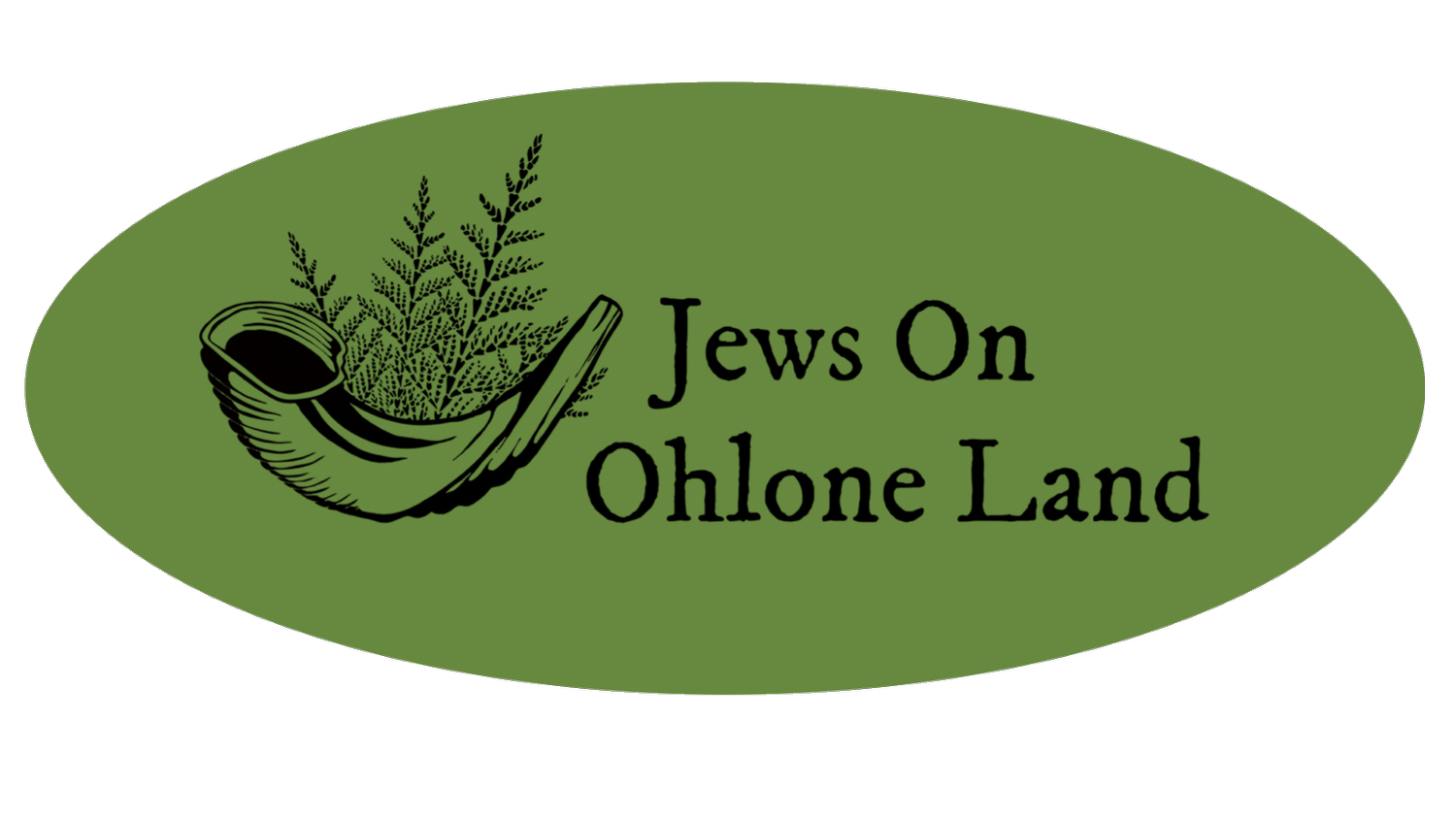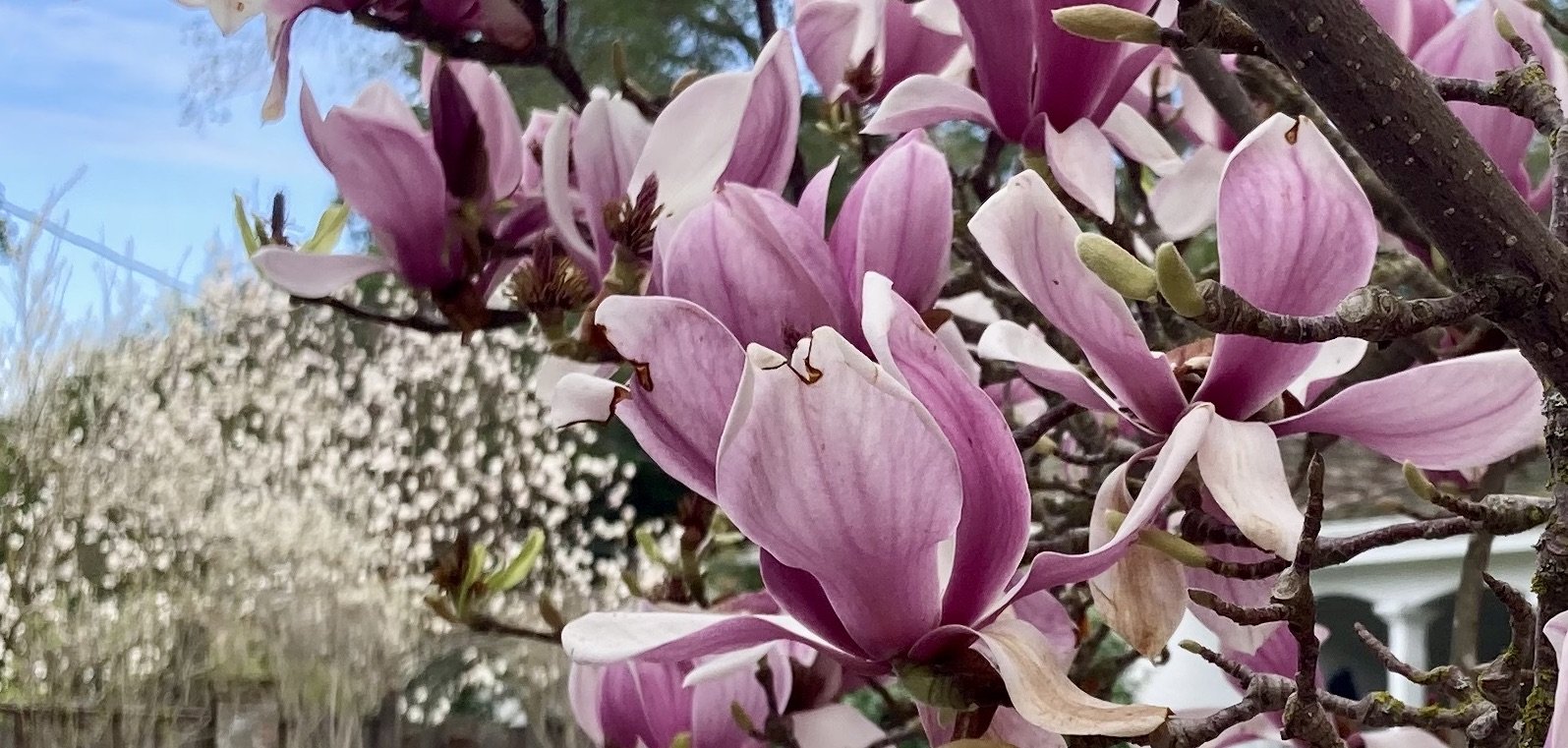Magnolias & Doikayt:
Listening for viable alternatives to Zionism
Written by Leora Cockrell
It’s late winter/early spring here in Huchiun. Magnolia branches are covered in fuzzy buds and full cream, blush and magenta blossoms. The ground beneath them is strewn with fallen petals etched with shoe treads from morning walkers on the water-sogged sidewalks. Magnolias are primordial, one of the oldest flowering plants, over 100 million years old. While some Magnolias are native to this continent, the trees currently in bloom in Huchiun are originally from China. You can determine the difference of origin based on whether or not the blooms or leaves develop first. When blooms develop first that indicates the trees originated somewhere with milder spring climates where the blooms were less likely to freeze, as is the case with Chinese-lineage Magnolias. Conversely, those from eastern North America develop leaves first, waiting longer to produce flowers given the late spring frosts in their homeland (Harvard Arboretum).
While I did not grow up aware of them, magnolia blooms have now become a trusted sign of early spring for me. Not alone in my admiration of their beauty, one resident of Huchiun has even made a map of early spring blooming magnolia trees in their surrounding neighborhood. But how did these ancient flowering trees, who share cousins native to this continent, find their way here? What does it mean for me to look to these trees as a sign of spring? What does mapping them on top of a city grid represent? Or interacting with them while standing on a side-walk? Or the fact that while I grew up only two hours away in the foothills where it does freeze in spring, I had never noticed a magnolia tree until after I left home?
Letting the Magnolia tree questions rest beneath the soil, we can shift our attention towards a related yet different topic - humans. Specifically how do humans, both like and unlike plants, find, make and, when necessary, leave home? And what might we be able to learn from plants in our processes of finding, making and leaving home?
Here in Huchiun, I am part of a Jewish political and cultural project called Jews On Ohlone Land (JOOL). Together, we hold many complex questions. At the heart of these questions, I feel we are asking how to find, make, and sometimes leave, home. We are holding these questions preciously, slowly weaving a basket for the question to live within and with any luck, one day grow beyond. We have woven this basket out of an agreement that holding these questions is necessarily collective, sometimes slow, definitely relational, sometimes painful, and essentially embodied.
“I feel we are asking how to find, make, and sometimes leave, home.”
We are holding these questions primarily as European-descent Ashkenazi Jews without lineages Indigenous to this continent. Therefore we are asking the question from the positionality of being settler-colonists, or at least benefitting from settler-colonialism, likely also being of refugee immigrant lineages and living on stolen land that is not of our ancestral lineages. We have a direct accountability relationship with Sogorea Te Land Trust’, an Indigenous, women-led urban land trust of the sovereign Lisjan, Ohlone Nation. We educate and activate local Jewish people to support Indigenous sovereignty through paying a land tax called Shuumi, include Indigenous solidarity in all levels of Jewish education and mobilize Jewish people to show up for Indigenous-led actions and events. Following local Indigenous leadership terminology, we are also here as guests to our Indigenous hosts.
In tandem with being guests of local Indigenous people, we are also cultivating our own cultural sense of being meaningfully Jewish in diaspora, and specifically as guests in Huchiun. Rabbi Dev Noily, co-founder of JOOL, asks how do our ancestral rituals like Havdalah adapt in the context of being held at the West Berkeley Shellmound? How does Havdalah stay the same and how does it evolve when we are in a fenced parking lot at night, next to a freeway overpass, sometimes harassed by guards, weaving flowers from a Jewish farm into the fencing and directing our collective prayers towards the return of that land to the Lisjan Nation?
The last line of JOOL’s purpose reads:
Living as whole people in diaspora, fully present on Lisjan Ohlone land and deeply rooting in our own ancestral ways and teachings, we are building beloved Jewish community in alignment with this place and Indigenous people.
What does it mean to live as whole people in diaspora? To me, it means knowing that our expression of Judaism is not lesser because we are in diaspora, in fact, there are important ways Judaism can grow and evolve only outside of the Zionist project. To me, it means that we are facing the consequences of the impacts of our people coming here, what happened/is happening in this land, and how we benefit today from settler-colonialism and the genocide and removal of Indigenous people. It also means including ourselves in visions of collective liberation and healing from our own ancestral and on-going trauma. It means acknowledging and accepting, with love, that we are not whole and cannot be until every being is allowed to express their wholeness.
Living as whole people means when we talk about “Jewish safety” what we are really talking about is the safety of all humans everywhere. And when we are talking about the safety of humanity, what we are really talking about is the safety of the earth and all life. It means we know that nation states anywhere, ultimately, cannot create safety for humans because of their disregard for the land and life.
Living as whole people is a prefigurative prayer - we are saying what we wish to one day be true in the present tense. It means when we envision fully rematriated futures where all land is under the care of sovereign Indigenous peoples, we know that the land is being lovingly encouraged to express their wholeness. It means knowing that some Indigenous people, when listening to the land, may need to ask their guests to leave for the sake of the land or their people.
“When we envision fully rematriated futures where all land is under the care of sovereign Indigenous peoples, we know that the land is being lovingly encouraged to express their wholeness.”
In the late 1800s and early 1900s the secular Jewish Socialist Labor Movement (aka Jewish Labor Bund) in Eastern Europe focused on the Yiddish term doikayt or “hereness.” Doikayt was held up in contrast to the “thereness” of yearning, or actually moving, to Palestine. Proponents of doikayt wanted to focus on the local struggles in the places they lived. They wanted culture, not a state, to be the defining characteristics of peoplehood.
While I am not personally the kind of anti-Zionist that believes Jewish people should not live in Palestine, I am the kind of anti-colonialist that believes people living anywhere should do so in reverence and right relationship with their local ecosystems and the Indigenous stewards. I am also someone who believes that cultural and ancestral ties to land and place are sacred and help humans understand ourselves as connected to long webs of time and lineages.
It is through my felt-sense of my ancestral connection to the land of Palestine that I have a glimmer of understanding of what it means to love and be from one’s ancestral homeland. It means I have a sliver of a notion of what it means for part of my sense of self to be the land - the particular ecosystems, patterns, plants and animals that my ancient ancestors observed, interacted with and wrote sacred laws about that have been passed down through the generations to me. I loved visiting the Negev desert in my mid-twenties; I loved imagining the footsteps of my ancient ancestors following their herds of goats across the landscape to food and water. I love knowing that their knowing of that place flows in my body.
It is through that love that I know that I don’t want one of my ancestral homelands to be destroyed by bombing, large infrastructure out of sync with the ecosystem or senseless violence against any humans living there. It is through that love that I wish my European-descent Jewish kin had arrived with more collective humility, asking Palestinians if they may return to and share both of their ancient homelands. If they may learn from Palestinians and others, including Jewish people who never left, how to care for the land they’ve been away from for so long. If they had promised themselves they would not pick up the tools of European supremacy and settler-colonialism that had just devastated their communities, and would instead choose solidarity relationships with their new hosts/neighbors/cultural siblings. If they had asked for help healing from the tremendous trauma they had just been through. If they had laid down on the land and listened.
“If they had promised themselves they would not pick up the tools of European supremacy and settler-colonialism ... and would instead choose solidarity relationships with their new hosts/neighbors/cultural siblings. ”
My Eastern European Jewish maternal lineages brought me to Turtle Island. They brought me to a place already devastated by genocide of Indigenous and Black people before they arrived. They were able to escape some of the worst anti-semitic violence by coming to this continent. Their positionality shifted from being on one of the lowest social rungs in Europe, to a few rungs up the ladder in America structurally above Black and Indigenous people.
In being critical of Zionism, I am aware I cannot absolve myself of Jewish involvement in or material benefit from settler-colonialism. I need only to look at the earth beneath my feet, or rather the concrete covering the earth beneath my feet, where tidal marshes used to exist. I am here, in part, because of colonization. I live in a settler-colonial nation.
Viable alternatives to Zionism mean, to me, viable alternatives to all nation states, settler-colonialism and white supremacy, both structurally and culturally. By that I mean, both the return of all land to Indigenous stewardship and the return/evolution of all humans to understanding ourselves as creatures who live within ecosystems that we have the capacity to positively impact.
The Chinese-based Magnolia would not have survived in my foothill town with spring frosts. Yet just two hours East in the protected climate of the Bay, they thrive and offer their beauty every spring. Where are the places that we can find and make home and offer back something of beauty? And when things change, how can we adapt or, like a magnolia petal leaving its place on the tree, how can we be ready to gracefully leave if we are asked to do so?



